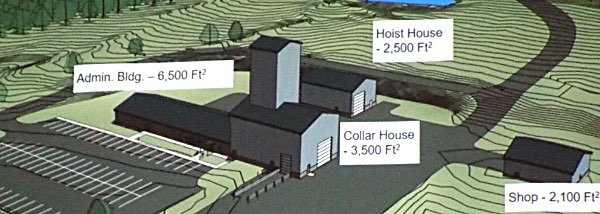- By Dan Veaner
- News
 Print
Print  Rendering by Cargill Deicing Technology
Rendering by Cargill Deicing TechnologyA standing-room-only crowd filled the Town courtroom Monday, when the Lansing Town Planning Board conducted a public hearing Monday to consider site plan approval for surface facilities for the proposed Cayuga Salt Mine shaft #4. After a brief explanation of the project by Cargill Mine Manager Shawn Wilczynski and Senior Project manager William Gracon, the floor was opened to the public. A half dozen Cargill employees passionately defended the company and the project, citing its safety record and stressing that the safety of mine employees is the key reason for the shaft.
"This project isn't born from corporate greed, as some may wish you to think," said 38 year mine employee Brian Bartlett. "Instead it's a necessary project that will allow us to maintain and further our commitment to the safety of people who go a half a mile underground each day to perform difficult and important work. I encourage you to vote in favor of supporting this project, allowing our employees the opportunity to work under conditions most people take for granted every day at their workplace: breathing adequate, clean air, being able to exit in a reasonable amount of time in emergency situations, and, in the event of injury or illness, to have professional care available at the earliest possible moment."
Bartlett and his fellow employees stressed the company's safety record, and argued the shaft is necessary for a safe working environment. Currently air is brought down to the mine through an existing shaft, about seven miles away from the active mining area beneath Cayuga Lake. Company officials explained that they are at the limit of the distance they can safely circulate air unless a new shaft closer to the work area can be constructed. The closer shaft will also reduce commuting time, and provide electricity more reliably.
Residents and interested parties from neighboring communities raised questions about water quality and the issues relating to cutting through the aquifer. Traffic impacts of displacing the current mine traffic from its location north of Portland point to the new site were expressed. Concern about the use of farm land for industrial use was raised, as well as zoning issues. A number of comments raised concerns about groundwater runoff.
"Our property shares a boundary line of 1,351 feet, more than a quarter of a mile with Cargill," said Carrie Koplinka-Loehr. "More than 70 households are located within a half a mile of Cargill's parcel, and all of us are likely to be negatively impacted by the surface phase of this project unless the Town and Cargill go beyond what's required to be good neighbors."
While activists are challenging the permit issued by the DEC to the project, Town Attorney Guy Krogh explained why the Planning Board does not have the authority to conduct its own environmental review in this case. The DEC, as lead agency in the shaft consideration, issued a 'negative declaration' of environmental impact, which means they have determined there is no significant impact of the project to the environment.
"Whether you agree with it or not, a coordinated review means you do not have the authority to issue your own superseding opinion," Krogh explained. "Once the lead agency issues a determination it's binding on the other agencies until it is reopened by the lead agency. Nonetheless there is a standing negative declaration. As an involved agency that's binding on you. There is not an environmental review that you need to undertake here, because the project is defined as the amendment to the permit to mine shaft 4."
After the public hearing Planning Board members discussed each issue raised, dismissing some as misunderstood information, and reconciling others with current zoning law and planning procedures. Planning Board Chairman Tom Ellis recommended putting a condition on the site plan preventing Cargill from expanding the use of Shaft #4 to include bringing salt product up from the mine and storing it on the site.
Wilczynski said three existing salt pads range from 150 to 200 feet wide by about 500 feet long. he said it would not be feasible to put adequately sized storage pads on the new site.
"Any changes require a new review process," he said. "There is no rail access there. It is not a feasible location. The current footprint at the Lansing facility consumes about 80n acres. This is 58 acres. This location and size would not support or sustain us moving our operations. We ship about 25% or our product by rail."
He said that if 50 years down the road the company wanted to bring product up closer to the active mine area, they would probably purchase land in the industrial zone near the Cayuga Power Plant, not at the Shaft #4 location.
Town officials later noted that moving an enormous underground salt filtering plant and seven miles of conveyor belts would likely be prohibitively expensive, making it unlikely that the company would switch away from the current shaft used to bring salt out of the mine.
Planning Board members appeared, by and large, to be comfortable with recommending the site plan to the Town Board, but some, Ellis in particular, felt it was important to include the caveat strongly encouraging the company to refrain from using the shaft to bring salt product to the surface, on the grounds that there was strong public concern on that point. Krogh noted that the Planning Board has no authority over that point, but Ellis said he felt it was important to include it, if only as a 'whereas' in the resolution recommending the project to the Town Board that the Planning Board is expected to vote on at its October 30th meeting.
v13i



